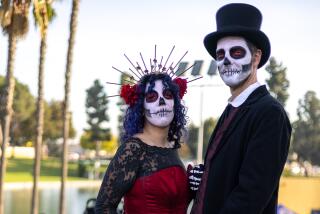Southland’s Dia de los Muertos events take on a life of their own
Dia de los Muertos is anything but dead, and it’s increasingly coming to life in Southern California in old and new ways.
With Mexico’s traditional Day of the Dead approaching, the number and kinds of events are growing in the Southland. Concert promoters, art galleries featuring Mexican folk art and merchants — big and small — are taking advantage of these celebrations and in some cases extending the merchandising of Halloween.
Once observed quietly in Latino communities, U.S. festivities are becoming more mainstream and, typically, louder and more visible than in years past. Corporations are getting more involved as sponsors and participants. Theme parks are adding Latino touches to their Halloween attractions. Party stores have amped up their offerings. And bakeries are already cooking up special treats.
There’s no better place to see this growing U.S. interest than at Hollywood Forever Cemetery’s 13th annual Dia de los Muertos festival on Saturday. It includes a traditional procession, musical performances and more than 100 homemade altars set up to honor the dead. Organizers expect 20,000 people this year, up from 300 in the event’s first year.
“It’s something that has grown through a sort of overwhelming interest of the general public, not just Latinos but the greater L.A. County community,” said Jay Boileau, the cemetery’s executive vice president and cultural events director. “Its popularity exceeded our expectations. What started as a traditional event kept growing and growing.”
For the first time, multinational food giant Nestle has jumped into Day of the Dead festivities, partly as a way to promote Abuelita, its popular Mexican-style hot chocolate. Nestle is a sponsor of the Hollywood Forever Cemetery event, at which the company is serving free hot chocolate, and it has launched a marketing campaign involving Facebook and Pinterest social media websites.
“This year we’ve been very integrated around Dia de los Muertos,” said Juan Motta, head of emerging markets business for Nestle. “It’s a day that’s growing in terms of interest in this country both by bi-cultural Hispanics and the general community.”
Another major celebration takes place Nov. 2 in Boyle Heights, sponsored by the Boyle Heights art center Self Help Graphics & Art with co-sponsors such as Walt Disney Co. and Sony Pictures Entertainment. It’s one of the longest-running Day of the Dead celebrations in the nation, and for years it has also featured an elaborate procession, this year starting in Mariachi Plaza. The art center also has displays with life-size papier-mache skeletons.
Before the Los Angeles event started in the early 1970s it was mostly celebrated at local homes, but Mexican American artists saw the holiday as an opportunity to explore their identity, Self Help Graphics Executive Director Evonne Gallardo said.
“It’s evolved,” Gallardo said. “Today, it’s much less looking to Mexico for how it’s expressed and celebrated and more reflective of what it’s like for a Chicano or recent arrival to L.A.”
Everywhere you go next week watch for sugar skulls, brightly colored paper decorations and the omnipresent skeleton statues in many poses and involved in many activities. These folk art figurines are often put on display by people commemorating their departed relatives. The figures have seen explosive growth in all kinds of media, including sugary treats and tattoos. Often they blend in with Halloween decorations.
It’s all a part of activities that have grown out of the Roman Catholic celebration of All Saints’ Day on Nov. 1 and All Souls’ Day on Nov. 2. Activities begin with Halloween on Oct. 31, also known as All Hallows’ Eve. Day of the Dead festivities follow for the next two days.
With increasing involvement of corporations and the proliferation of merchandise, some worry about over-commercialization of a once more serious holiday.
“I never want it to become what Christmas, Easter and Halloween have become,” said Gallardo, “which is a total disconnect from the spiritual reason why we celebrate.”
Rochelle Newman-Carrasco, chief Latino marketing strategist for marketing firm Walton Isaacson, agreed. “It should be about sharing cultural insights in a respectful way and not trivializing it,” she said.
Regina Marchi, author of the 2009 book “Day of the Dead in the USA: The Migration and Transformation of a Cultural Phenomenon,” said many people have the misconception that the holiday was commercialized in the U.S. and that in Mexico it’s a pure, authentic ritual.
“In reality it became incredibly commercialized in Mexico before it became commercialized here,” Marchi said. “It’s definitely not something that’s worse in the U.S. The commercialization is taking place on both sides.”
Business is booming not only in the United States but around the world, said Angela Villalba, who operates Mexicansugarskull.com. Her Reign Trading Co., which distributes more than 1,000 Day of the Dead-related items including the popular sugar skull mold, last year moved from Rosemead to Santa Rosa in Northern California.
Villalba said she’s amazed at how the observances have evolved. She noted that there are now even Day of the Dead-themed weddings and altars built to beloved dead pets.
Dia de los Muertos, she said, “is the newest American holiday.”







